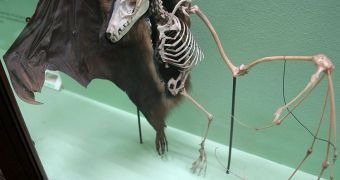A group of researchers from the United States Geological Survey (USGS) has determined in a new study that the most unobtrusive and non-invasive way of creating a census of bat populations and species over any given area is to listen for the high-pitched clicks these creatures produce.
Bats are entirely blind, and they navigate their surroundings by releasing a series of clicks, ultrasound-wavelength noises that bounce off objects around them like a radar beam. Their large ears pick up these echoes, which are then put together inside a 3D map inside their brains.
USGS scientists propose that acoustics experts could build specialized microphones capable of picking up these sounds, which are well above the normal hearing range for a human. These echolocation calls could then be used as an identity tag to figure out which bat species dominates any given habitat.
In a paper published in the latest issue of the Journal of Ecology and the Natural Environment, the team argues that this method could be used to keep tabs of bat populations that have been driven to the brink of extinction by the white-nose syndrome, a mysterious condition that kills off entire colonies very fast.
The new study was carried out by investigators at USGS working together with colleagues in the US Army, and at the Virginia Institute of Technology (Virginia Tech). The group says that the white-nose syndrome has thus far killed an estimated 6 million bats since 2006, in 22 American states and 6 Canadian provinces.
“Acoustic sampling is a noninvasive sampling technique for bats, and its use often allows for the detection of a greater number of bat species in less time than traditional sampling methods such as netting,” says Virginia Tech Cooperative Fish and Wildlife Research Unit expert W. Mark Ford.
“Low population numbers make netting both time and cost prohibitive. Netting also has low capture rates for WNS affected species. Moreover, acoustic sampling minimizes the handling of bats, which lessens the chance of unintended cross-contamination and exposure to the white-nose fungus from one bat to another or from equipment and personnel to uninfected bats,” he adds.
The acoustic sampling approach could also enable scientists to look for bat species featuring just a few remaining individuals, such as is the case with species nearing extinction. Sampling populations the old way, by capturing the actual animals, has proven impractical and unreliable.

 14 DAY TRIAL //
14 DAY TRIAL //